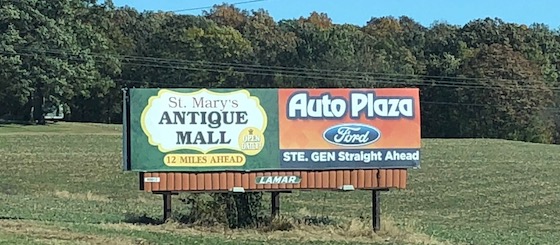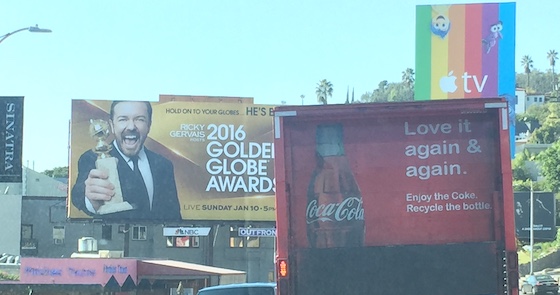Memo From Frank
April is the month in which most Americans see the actual truth of how much money they made for the year. There’s nothing more sobering than having to write a check to the IRS – and no moment that makes you more desirous for greater take-home pay. If you want to make more money this year, then consider adding on an additional income stream. And one great idea is the income that can be generated by billboard signs. A single wooden billboard can generate $3,000 or $4,000 per year in your pocket, and just ten of more of those might replace your day job. If you want to have greater cash flow and financial independence, then check out what billboards have to offer.
If I Was Starting From Scratch Today...

I started my billboard career in 1982 – that’s almost forty years ago! I’ve learned a lot over those past decades, and I always watch for where the opportunities are. Here’s what I’d do if I was starting over again today.
Pick a territory 4 hours radius from my house
Before you can start looking for billboards, you have to define a territory. You can’t just say “I’m going to own billboards” and then not narrow it down to a certain footprint. Obviously, someone in Maine should not look at a billboard in Oklahoma. For most people, the correct territory is simple: a 4 hour radius from your home. This means you can drive out to any location and back in one day.
Define the “hottest” part of that territory
Take that territory and now break it down into four quadrants (draw a line through the middle of the circle both vertically and horizontally). One of these four is the “hottest” market (new developments, higher traffic, more businesses). That’s where you’re going to want to focus first.
Get the state laws
A 4-hour radius from your home may take you into more than one state. Get the state billboard laws in each state in that circle. You can get them on-line or through that state’s Department of Transportation.
Refine the best state based on opportunity
Under the 1965 Highway Beautification Act, states are allowed to set their own laws on billboards as long as they are not less tough than the Federal law. So read the codes of all states in your “circle” and see what they each allow and which one is the “easiest” (allows signs with less spacing between them).
Get a state license
Get a billboard license in each state that you are going to be working in. They’re not expensive but take time and there’s no reason to delay, unless that state’s laws are so tough that it does not have good potential.
Get traffic count maps
Every state has “traffic count maps” that show how many cars per day go down the roads. You can get these from the Department of Transportation. They are an essential piece of the puzzle, since sign values are totally dependent on traffic counts.
Define which cities front those highways and roads
Although your territory looks large, remember that you are only interested in that finite set of property owners that front the highways (less than 1% of all that geography). You’ll want to make a list of every city limit that those roads go through.
Figure out which cities have the best opportunity
Get the ordinances to these cities with highway frontage on-line or by calling city hall and having them mail them to you. They are not very complicated to read. The key items are 1) zonings where signs are allowed 2) spacing between signs 3) maximum height 4) maximum size 5) any other material fact.
Get in your car and start driving these niches
You now know the laws of both the city and state, so it’s time to drive out and look around. See where there are un-built legal locations and what addresses those properties are.
Start talking to land owners and cutting leases
You can get the names and addresses of the property owners from the tax assessor’s office – as long as you have the addresses. With this information, you can now start sending them letters about wanting to lease their land for a billboard, or giving them a call. Those calls will naturally lead into signing up leases with the agreeable ones.
Get permits
With a ground lease in hand, it’s time to apply for your state and/or city permit. Most permits require you to fill out a standard form and make a sketch of where the sign is to. You may also need standard engineering from a billboard fabricator.
Build or sell
Once you get your permit in hand, it’s time to decide whether you want to build the sign or sell it to someone else. There are many people who buy assignments of leases and permits to grow their own billboard portfolio. However, you are always better off financially to keep and build the sign yourself in most cases.
Repeat
Billboards are like Lay’s Potato Chips – you can’t be satisfied with just one. Now that you know the process, why would you stop there? I’ve built 10 signs before in one city at one time. It just makes sense from a time efficiency standpoint.
Conclusion
If I was starting again today, these are the exact steps I would follow. That should give you a road map.
Why You Need Obstruction Protection In Every Billboard Lease

A billboard is based on being seen. Without visibility, they have no value. You could a billboard on the busiest highway in the U.S. (the 405 Freeway in Los Angeles) behind a building where nobody could see it and it would be worthless. So if visibility is so important, how can you protect yourself?
Understanding the entire issue of blockage
For a billboard to be defined as having a satisfactory read, it has to have no blockage for 500’. That’s about the distance from when you can first actually read the ad. It does not mean that the sign has to be free of blockage for thousands of feet. Some people freak out when they see a tree in front of a sign at a distance of 1,000 feet, but you can’t read the ad from that distance, so who cares? But any sign that has less than 500’ of clear read is considered impaired.
Protection from your property owner blocking you
In a good billboard lease, the sign owner has a protection from the landowner himself blocking the sign. The lease provides that the land owner cannot block the sign and the sign company is allowed to remove any obstruction. Why would the land owner want to block the sign on their own land? Sometimes what happens is that the land owner gets an offer to rent their land to a business, and that business ends up building their own sign in front of yours. Another time is when the land owners wants more money from you’re a decade from now, and threatens to block your sign with a U.S. flag if you don’t comply. These cases are relatively rare but you have to be protected.
Protection from someone else blocking you
The other form of blockage can come from a neighbor who builds an item (either naturally like a tree or man-made like a building) in front of your sign. Sometimes this is accidental and sometimes it’s deliberate. You cannot put language in your lease about this since the land owner cannot stop the neighbor’s actions, but you can still protect yourself in your lease by giving yourself the option to remove the sign if you can’t rent the ad space. While I’ve never had to do that, it’s a great insurance policy.
Conclusion
Blockage can be a big deal with a billboard, so you have to protect your investment. These are the methods that smart operators use to mitigate their risk.
The Ultimate Billboard Boot Camp
![]() How to Find a Billboard Location
How to Find a Billboard Location
![]() How to Buy a Billboard
How to Buy a Billboard
![]() How to Build a Billboard
How to Build a Billboard
![]() How to Operate a Billboard
How to Operate a Billboard
![]() How to Rent Ad Space on a Billboard
How to Rent Ad Space on a Billboard
![]() How to Sell a Billboard
How to Sell a Billboard
Get Your Copy Now!
Rituals That Can Save You A Fortune When Building Any Billboard

Building a billboard can be a seemingly complicated process, but there are only a few critical steps that you have to be an active participant in. So what are these important steps to watch over?
“Flag” the location with relative precision
You should never build a billboard – ever – without first “flagging” the location to know exactly what it will look like, This protects you from disappointment. You can do this with either a flagging pole or hiring a small skyhook crane. This will ensure that you have clear visibility and are high enough.
Make sure you 100% understand the laws on setback, size and height
You can’t build the sign until you are an expert on three simple items: setback from the street and property lines, the maximum height and the maximum size. You cannot go back later and fix these if you screw up. You need to know the laws before you build, not after.
Drive the access to make sure you can get through with our vehicle
There’s no greater catastrophe than having the heavy equipment show up and then not being able to actually get to your billboard location. How do you test that? Simply drive your car from the main street to the sign location. If your car can’t make it, then the sign definitely won’t be able to.
Triple check the exact location before you put in the stake
Don’t measure the sign’s location only once and put in the stake. Do it at least three times. This is no time for a math error. It only takes 5 minutes more to triple check your work.
Check it again on construction day
I once went out to the job site and found that somebody had moved my stake (probably a kid). What a mess it would have been if I had not checked on that. Always triple check the location before digging.
Get the utilities marked
When digging a hole anywhere in the U.S., it’s important to have a utility locate performed first. Most states have a one-call resource where you simply call and tell them where you will be digging and they dispatch all utilities to check for free. Do it.
Verify the depth of the hole and drop a dime down it
The height of any sign is dependent on how deep the foundation is. For example, if your sign is to be 50’ tall and the sign fact is 10’ high, then you need 40’ of pipe from the ground level. If the pole is 50’ long and they dig the hole 14’ deep by accident, your sign is only going to be 46’ high. So do the math in advance and stand there while they dig the hole and drop a tape measure down it to make sure the hole is the correct depth. Once you have checked and it’s done, then drop a dime down it so that you know the job is complete. You can then see the dime to make sure it has not been altered.
Be there when the “V” is set
The final step is to make sure you are there when they position the pole in the hole. The way the pole is oriented will determine the “V” on the top of the sign, which will impact the angle of view. Stand there and make sure the installer has the “V” set correctly. I once failed to do this and when I went back out it was installed backwards!
Conclusion
If you want to have an easy and low-stress experience building a billboard, then these are the action steps you want to follow and be on-location for. None of these are difficult, but they are essential if you want peace-of-mind.
